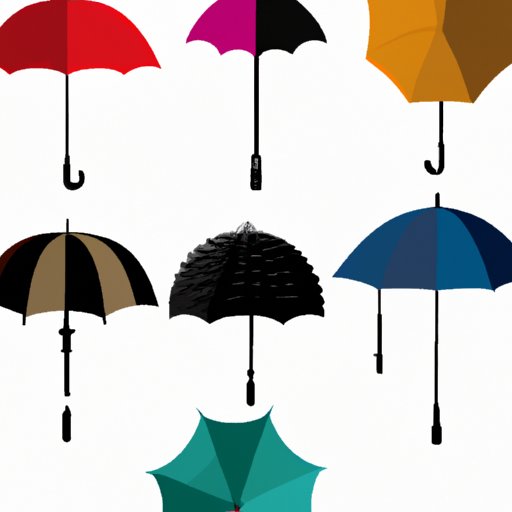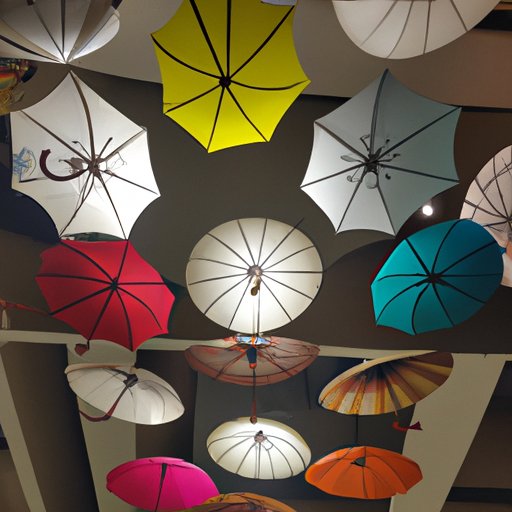Introduction
An umbrella is an essential item for many people, used for protection from sun, wind, and rain. But when were umbrellas invented? This article will explore the fascinating history behind the invention of the umbrella, from its early beginnings in ancient cultures to its evolution into the iconic symbol it is today.

Exploring the History of Umbrellas: From Ancient Inventions to Modern Icons
Umbrellas have been around for centuries, with evidence of their use in ancient Egypt, Greece, and Rome. In ancient times, umbrellas were primarily used for ceremonial purposes and as a symbol of status and power. They were made out of materials such as linen, leather, and oiled paper, and were often decorated with jewels and tassels.
By the 16th century, umbrellas had become more commonplace and were being used by both men and women. However, they were still not as widespread as they are today. Over the next few centuries, umbrellas underwent a number of developments in terms of materials, designs, and technology, eventually becoming an everyday accessory.
A Brief Timeline of the Invention of the Umbrella
The earliest known umbrellas were used in ancient Asia. The Chinese are credited with inventing the first collapsible umbrella in the 5th century BC. This umbrella was made out of bamboo and oiled paper, and was designed to protect against the sun and rain. The Chinese also developed the first waterproof umbrellas.
By the 11th century, umbrellas had spread to Europe, where they were used primarily by royalty and the wealthy. By the late 1500s, umbrellas had become popular among all classes of society, although they were still seen as a luxury item. It wasn’t until the 18th century that umbrellas began to be mass-produced and became more affordable.
In the 19th century, advances in technology led to the development of new materials and designs for umbrellas, including lighter materials such as silk, cotton, and rayon, as well as collapsible designs. This led to the invention of the modern umbrella, which we know and love today.

How the Umbrella Evolved Through the Ages
Over time, umbrellas have evolved in terms of materials, design, and technology. In the early days, umbrellas were made out of heavy materials such as linen, leather, and oiled paper. As technology advanced, lighter materials such as silk, cotton, and rayon were used to make umbrellas, making them lighter and easier to carry. Additionally, collapsible designs were developed, allowing umbrellas to be folded up and stored in small spaces.
Today, umbrellas come in a variety of shapes, sizes, and colors, and are made out of a range of materials, from traditional fabrics to modern materials such as nylon and polyester. Additionally, new technologies such as automatic open/close mechanisms and windproof designs have been introduced, making umbrellas even more practical and convenient.

The Fascinating Story Behind the Invention of the Umbrella
The history of umbrellas is steeped in legends and lore. There are several origin stories associated with the invention of the umbrella, all of which involve mythical gods and goddesses. One such story involves a Chinese goddess named Leizu, who is said to have invented the umbrella after discovering silkworms and their cocoons.
Umbrellas also have long been associated with cultural symbolism. In some cultures, umbrellas are seen as symbols of protection and shelter, while in others they are seen as symbols of status and wealth. In many cultures, umbrellas are also seen as symbols of good luck and fortune.
Who Invented the Umbrella and When?
The exact inventor of the umbrella is unknown, and there are a number of theories about who was responsible for its invention. Some believe it was the ancient Greeks, while others claim it was the Chinese. Still others point to ancient Babylonian and Assyrian cultures as being responsible for the invention of the umbrella.
What is certain, however, is that umbrellas were invented sometime between the 5th century BC and the 11th century AD. The Chinese are credited with inventing the first collapsible umbrella in the 5th century BC, while the spread of the umbrella to Europe occurred in the 11th century.
An Overview of the Different Types of Umbrellas Throughout History
Throughout history, umbrellas have come in a variety of shapes, sizes, and materials. Traditional umbrellas were made out of heavy materials such as linen, leather, and oiled paper, and had large canopies. Modern umbrellas are typically made out of lighter materials such as nylon and polyester, and feature collapsible designs.
In addition to traditional and modern umbrellas, there have been a number of innovative designs over the years. For example, the telescopic umbrella, which features a retractable handle and canopy, was invented in the 19th century. More recently, umbrellas have been designed with built-in LED lights and solar panels, as well as air-filled canopies for improved wind resistance.
Conclusion
Umbrellas have been around for centuries, evolving from ancient inventions to modern icons. While the exact inventor of the umbrella is unknown, it is clear that umbrellas have come a long way since their early beginnings. Today, umbrellas come in a variety of shapes, sizes, and materials, and are used for both practical and symbolic purposes.
From ancient Asia to modern Europe and beyond, umbrellas have played an important role in human history. They have been used for protection from the elements, as symbols of status and power, and as a source of comfort and security. The fascinating story behind the invention of the umbrella is one that continues to captivate and inspire.
(Note: Is this article not meeting your expectations? Do you have knowledge or insights to share? Unlock new opportunities and expand your reach by joining our authors team. Click Registration to join us and share your expertise with our readers.)
